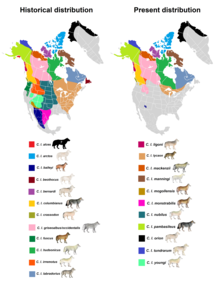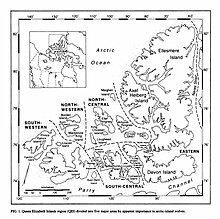Arctic wolf
| Arctic wolf | |
|---|---|

| |
| Scientific classification | |
| Domain: | Eukaryota |
| Kingdom: | Animalia |
| Phylum: | Chordata |
| Class: | Mammalia |
| Order: | Carnivora |
| Family: | Canidae |
| Genus: | Canis |
| Species: | |
| Subspecies: | C. l. arctos
|
| Trinomial name | |
| Canis lupus arctos Pocock, 1935
| |

| |
| Historical and present range of grey wolf subspecies in North America | |
The Arctic wolf (Canis lupus arctos), also known as the white wolf or polar wolf, is a subspecies of grey wolf native to Canada's Queen Elizabeth Islands, from Melville Island to Ellesmere Island.[1] It is a medium-sized subspecies, distinguished from the northwestern wolf by its smaller size, its whiter colouration, its narrower braincase,[2] and larger carnassials.[3] Since 1930, there has been a progressive reduction in size in Arctic wolf skulls, which is likely the result of wolf-dog hybridization.[3]
Taxonomy


In 1935, the British zoologist Reginald Pocock attributed the subspecies name Canis lupus arctos (Arctic wolf) to a specimen from Melville Island in the Queen Elizabeth Islands, Canada. He wrote that similar wolves could be found on Ellesmere Island. He also attributed the name Canis lupus orion to a Greenland wolf specimen from Cape York, northwest Greenland.[6] Both wolves are recognized as separate subspecies of Canis lupus in the taxonomic authority Mammal Species of the World (2005).[7]
One study using autosomal microsatellite DNA and Mitochondrial DNA (mtDNA) data indicate that the Arctic wolf has no unique haplotypes which suggests that its colonization of the Arctic Archipelago from the North American mainland was relatively recent, and thus not sufficient to warrant subspecies status.[8] However, the research of Chambers et al. (2012) that dismissed the Arctic wolf's genetic integrity became controversial, forcing the United States Fish and Wildlife Service (USFWS) to commission a peer review of it, known as the National Center for Ecological Analysis and Synthesis (NCEAS) (2014).[9] This peer review highlighted numerous flaws in the research such as the erroneous merging of the coastal British Columbia island wolves with the inland Canis lupus nubilus as well as suggesting that grey wolves never lived in the eastern third of the US, and thus concluded unanimously that the Chambers' review "is not accepted as consensus scientific opinion or best available science."
Behaviour
The Arctic wolf is relatively unafraid of people, and can be coaxed to approach people in some areas.[10] The wolves on Ellesmere Island do not fear humans, which is thought to be due to them seeing humans so little, and they will approach humans cautiously and curiously.[11][12][13][14] Otto Sverdrup wrote that during the Fram expedition, a pair of wolves shadowed one of his teammates, who kept them at a distance by waving his ski pole.[15] In 1977, a pair of scientists were approached by six wolves on Ellesmere Island, with one animal leaping at one of the scientists and grazing a cheek. A number of incidents involving aggressive wolves have occurred in Alert, Nunavut, where the wolves have lived in close proximity to the local weather station for decades and became habituated to humans. One of these wolves attacked 3 people, was shot, and tested positive for rabies.[16]

Very little is known about the movement of the Arctic wolves, mainly due to climate. The only time at which the wolf migrates is during the wintertime when there is complete darkness for 24 hours. This makes Arctic wolf movement hard to research. About 2,250 km (1,400 mi) south of the High Arctic, a wolf movement study took place in the wintertime in complete darkness, when the temperature was as low as −53 °C (−63 °F). The researchers found that wolves prey mainly on the muskoxen. There is no available information of the wolves' movements where the muskoxen were.[17]
Recovery
The Arctic wolf is of the least concern when it comes to being endangered but it does face threats of endangerment. In 1997, there was a decline in the Arctic wolf population and its prey, muskoxen (Ovibos moschatus) and Arctic hares (Lepus arcticus). This was due to harmful weather conditions during the summers for four years. The recovery of the Arctic wolf population came when summer weather conditions returned to normal.[18]
Diet
In the wild, Arctic wolves primarily prey on muskoxen and Arctic hares. They have also been found to prey on lemmings, caribou, Arctic foxes, birds, and beetles. It has been also found that Arctic wolves scavenge through garbage. This sort of food source will not always be found in the Arctic wolf's diet because of regional and seasonal availability.[19] Sometimes there is debate whether the muskox or the Arctic hare is the primary prey for the hare-wolf-muskox predator-prey system. Studies provide evidence that the muskoxen are indeed their primary prey because wolf presence and reproduction seems to be higher when muskox is more available than higher hare availability.[20] More supporting evidence suggests that muskoxen provide long-term viability and other ungulates do not appear in the wolf's diet.[21] Evidence suggesting that Arctic wolves depend more on hares claims that the mature wolf population paralleled the increase of hares rather than muskoxen availability.[22] The study goes on to say that degree of reliance between the two sources of food is uncertain and that the amount of consumption between the two species depends on the season and year.[22] Debate continues when seasonal and diet of young wolves is discussed. According to one study, muskox calves serve as a primary food source because the needs of pups are greater[23] but another study suggests that "when hares were much more plentiful (Mech, 2000), wolves commonly fed them to their pups during summer."[22] These differences may be attributed to location as well. Polar bears are rarely encountered by wolves, though there are two records of wolf packs killing polar bear cubs.[24]
References
- ^ Mech, L. David (1981), The Wolf: The Ecology and Behaviour of an Endangered Species, University of Minnesota Press, p. 352, ISBN 0-8166-1026-6
- ^ Goldman, E. A. (1964). Classification of wolves. In The Wolves of North America Part 2. Young, S. P. & Goldman, E. A. (Eds.) New York: Dover Publs. p. 430.
- ^ a b Clutton-Brock, J.; Kitchener, A. C.; Lynch, J. M. (1994). "Changes in the skull morphology of the Arctic wolf, Canis lupus arctos, during the twentieth century". Journal of Zoology. 233: 19–36. doi:10.1111/j.1469-7998.1994.tb05259.x.
- ^ Miller, Frank (1995). "Wolf-sightings on the Canadian Arctic Islands". Arctic. 48 (4). doi:10.14430/arctic1253.
- ^ Walton, Lyle (2001). "Movement Patterns of Barren-Ground Wolves in the Central Canadian Arctic". Journal of Mammalogy. 82 (3): 867–876. doi:10.1093/jmammal/82.3.867.
- ^ Pocock, R. I (1935). "The Races of Canis lupus". Proceedings of the Zoological Society of London. 105 (3): 647–686. doi:10.1111/j.1096-3642.1935.tb01687.x.
- ^ Wozencraft, W. C. (2005). "Order Carnivora". In Wilson, D. E.; Reeder, D. M. (eds.). Mammal Species of the World: A Taxonomic and Geographic Reference (3rd ed.). Johns Hopkins University Press. pp. 575–577. ISBN 978-0-8018-8221-0. OCLC 62265494. url=https://books.google.com/books?id=JgAMbNSt8ikC&pg=PA576
- ^ Chambers SM, Fain SR, Fazio B, Amaral M (2012). "An account of the taxonomy of North American wolves from morphological and genetic analyses". North American Fauna. 77: 1–67. doi:10.3996/nafa.77.0001.
- ^ Review of Proposed Rule Regarding Status of the Wolf Under the Endangered Species Act
- ^ Mech, L. D., Arctic Wolves and Their Prey, National Oceanic and Atmospheric Administration, May 30, 2007
- ^ Arctic Wolf: The High Arctic by Laura DeLallo. Bearport Publishing, New York 2011
- ^ Arctic wildlife in a warming world by Michael Becker. BBC Two, 2014.
- ^ Ellesmere Island Journal & Field Notes by Henry Beston 2006. International Wolf Centre.
- ^ Arctic Wolves and Their Prey by L. David Mech. National Ocean and Atmospheric Administration, Pacific Marine Environment Laboratory, Actic Zone. 2004
- ^ Sverdrup, O. N., (1918), New land; four years in the Arctic regions, Vol. I, London Longmans, Green, pp. 431–432
- ^ Linnell, J.D.C., et al. (2002). [1], NINA, pp. 29–31, ISBN 82-426-1292-7
- ^ Mech, David (2011). "Movements Of Wolves At The Northern Extreme Of The Species' Range, Including During Four Months Of Darkness". PLoS ONE. 6 (10): e25328. Bibcode:2011PLoSO...625328M. doi:10.1371/journal.pone.0025328. PMC 3186767. PMID 21991308.
{{cite journal}}: CS1 maint: unflagged free DOI (link) - ^ Mech, David. L (2005). "Decline and Recovery of a High Arctic Wolf-Prey System". Arctic. 58 (3): 305–307. doi:10.14430/arctic432. JSTOR 40512716.
- ^ Marquard, Peterson (1998). "Food Habits of Arctic Wolves in Greenland". Journal of Mammalogy. 79 (1): 236–244. doi:10.2307/1382859. JSTOR 1382859.
- ^ Mech, David (September 1, 2005). "Decline and Recovery of a High Arctic Wolf-Prey System". Arctic. 58 (3). doi:10.14430/arctic432.[permanent dead link]
- ^ Marquard-Petersen, Ulf (2012). "Decline and Extermination of an Arctic Wolf Population in East Greenland". Arctic. 65 (2). doi:10.14430/arctic4197.
- ^ a b c Mech, David (September 1, 2007). "Annual Arctic Wolf Pack Size Related to Arctic Hare Numbers". Arctic. 60 (3). doi:10.14430/arctic222.
- ^ Marquard, Peterson (October 2009). "Abundance, social organization, and population trend of the arctic wolf in north and east greenland during 1978–1998". Canadian Journal of Zoology. 87 (10): 895–901. doi:10.1139/z09-078.
- ^ Richardson, E.S; Andriashek, D (2006). "Wolf (Canis lupus) Predation of a Polar Bear (Ursus maritimus) Cub on the Sea Ice off Northwestern Banks Island, Northwest Territories, Canada" (PDF). Arctic. 59 (3): 322–324. doi:10.14430/arctic318. Retrieved March 16, 2010.
Further reading
- L. David Mech (text), Jim Brandenburg (photos) (May 1987). At Home With the Arctic Wolf. National Geographic 171(5):562–593.
- L. David Mech (1997). The Arctic Wolf: 10 Years With the Pack, Voyageur Press, ISBN 0-89658-353-8 .
